The Saintliest of All Sands
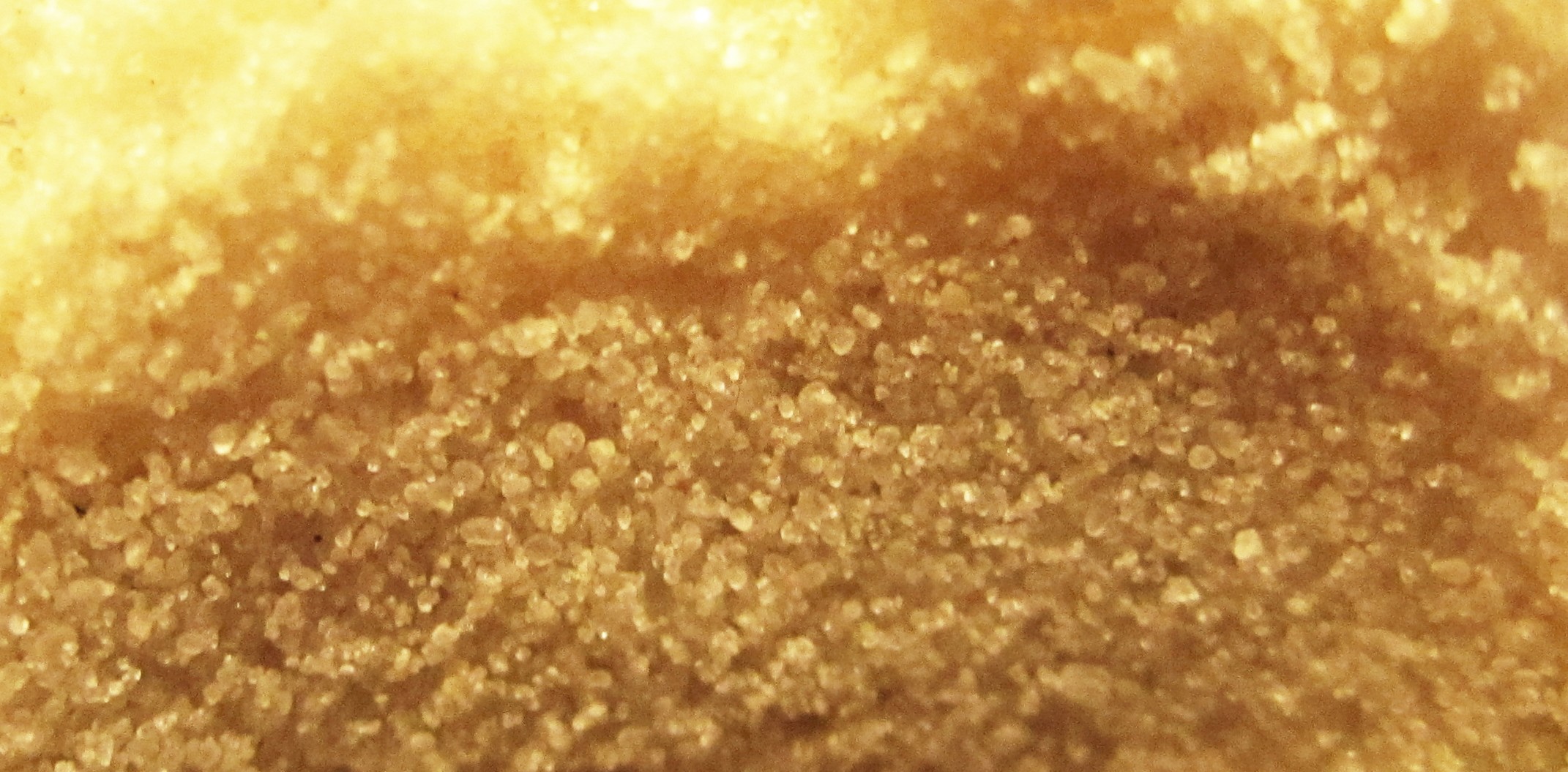
A majestic white rock that defies intuition is exposed in various locations throughout the Midwestern United States. It forms towering cliffs and bluffs that can be several hundred feet thick and completely vertical. It is so stable that it can support a dense network of caves, mines, and voids, yet so soft that it can be dug by hand! What is this strange rock unit, and why is it important?
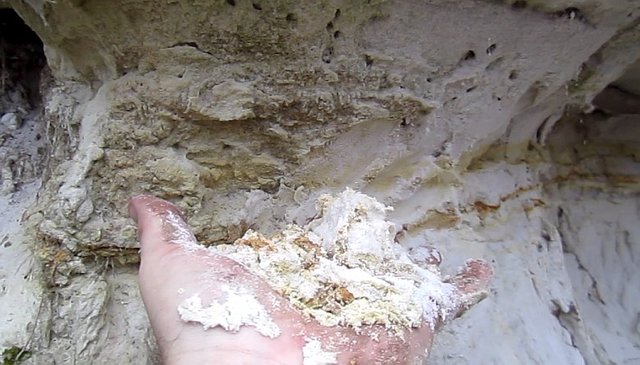 The ease with which this unit can be removed is incredible. A layer containing trace amounts of iron are visible as the red color in the outcrop.
The ease with which this unit can be removed is incredible. A layer containing trace amounts of iron are visible as the red color in the outcrop.
Deposition
The Saint Peter is a unit of sandstone that occurs in the central US continent. It was originally deposited during the Ordivician period, approximately 460 million years ago. At this time, there was a shallow inland sea covering the center of the continent, resulting in a large sequence of clean, homogeneous sands being produced by wave and wind action.
Distribution & Exposure
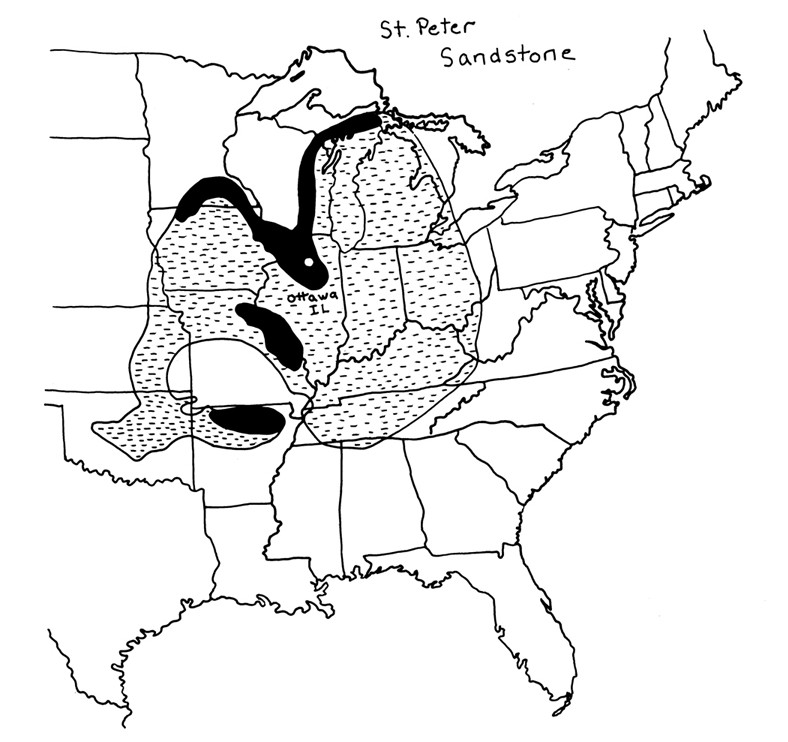 Source | Distribution of the Saint Peter Sandstone. Deposits at or near the surface are shown in black, while subterranean layers are indicated by the dashed areas.
Source | Distribution of the Saint Peter Sandstone. Deposits at or near the surface are shown in black, while subterranean layers are indicated by the dashed areas.
The Saint Peter formation has been identified in recovered cores throughout the Central US, and notably outcrops in Missouri, Illinois, Iowa, Wisconsin, Michigan, Arkansas, and Minnesota. Exposures in the more northern states generally occur along river valleys due to the prevalence of glacial drift and outwash in these areas. These river valleys were scoured out by torrents of water at the end of the last glaciation when the continental glaciers melted and glacial lakes (such as Lake Aggassiz) were drained.
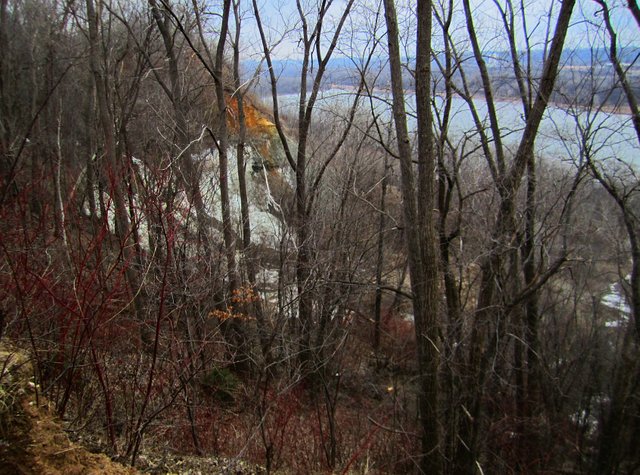 View from an overlook showing the deeply incised Minnesota River Valley and steep valley wall covered in spring-fed ice.
View from an overlook showing the deeply incised Minnesota River Valley and steep valley wall covered in spring-fed ice.
Type Locality
The Saint Peter Sandstone is named after the Saint Peter River, a waterway that is now known as the Minnesota River. In southern Minnesota along this river and larger cousin the Mississippi, there are several outcroppings of the sandstone in the deeply incised glacial drainages. After glacial waters receded, the depth of this valley incision lowered the water table relative to the surrounding highlands, causing springs and natural caves to develop in the bluffs.
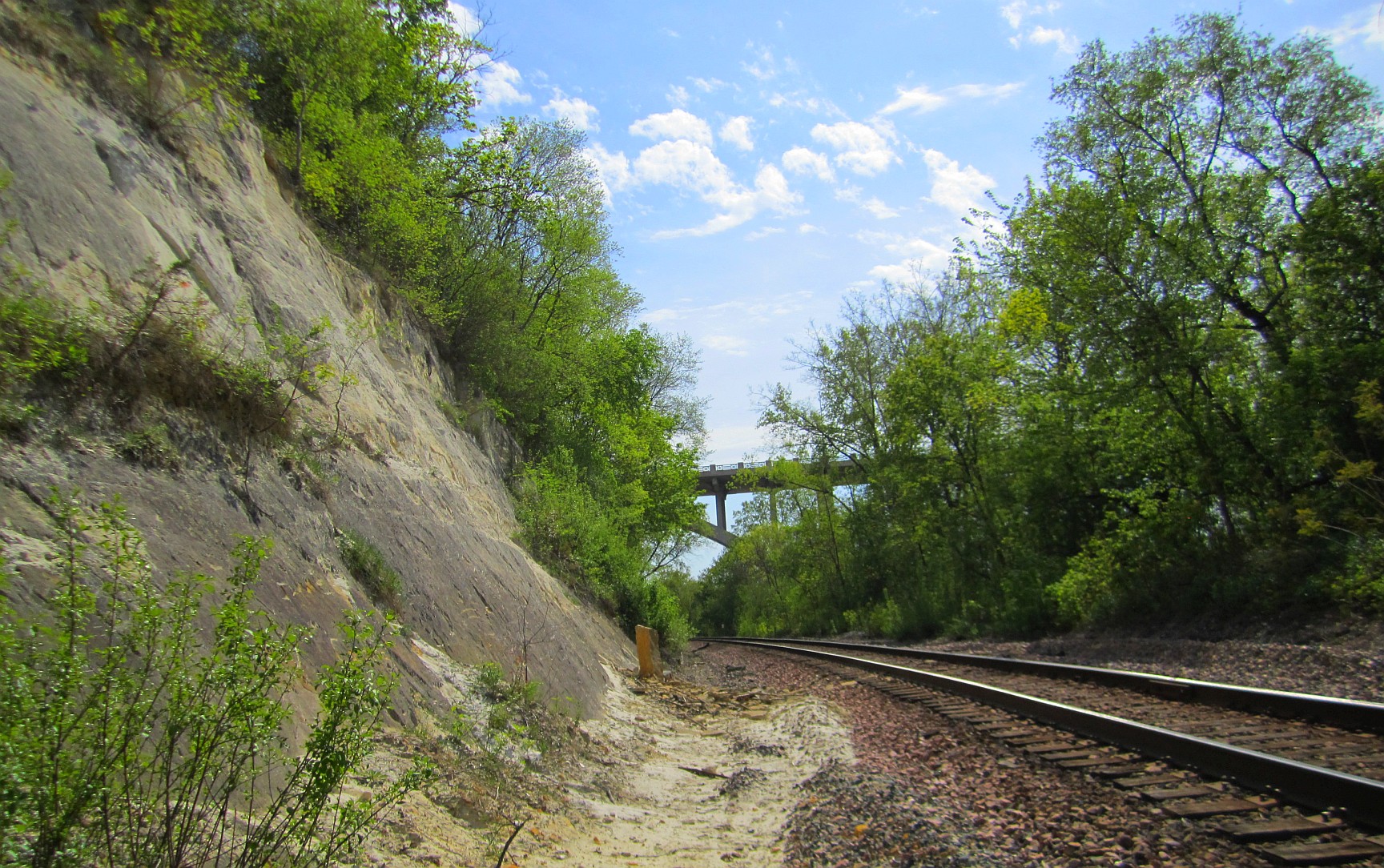 Railroad track hugging a Saint Peter bluff. Railroad companies tend to route through river valleys because of the relatively gentle grade.
Railroad track hugging a Saint Peter bluff. Railroad companies tend to route through river valleys because of the relatively gentle grade.
This deposit is also sometimes referred to as Ottawa Sand due to it's exposure at Ottawa, Illinois. Ottawa Sand is extremely useful as a standard for scientific experiments because once sieved the grains are very uniform and can be used in calibration.
Composition
The Saint Peter sandstone has a quartz (SiO2) purity of more than 95%, often reaching a purity greater than 99%. Because of this lack of impurities, it is recognized as an excellent source of silica for creating glass.
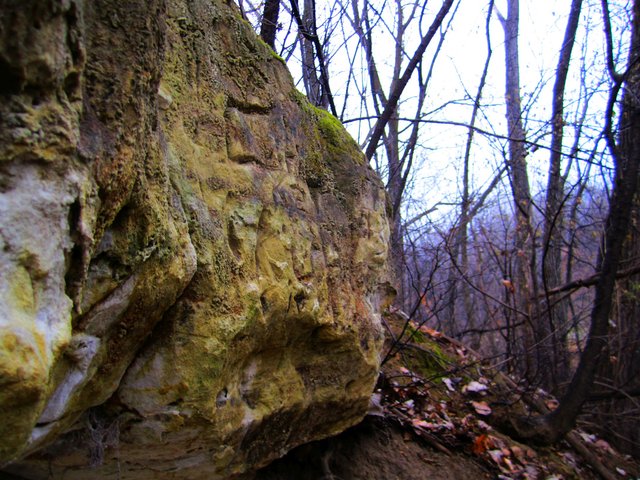 Saint Peter outcropping in a small urban park. Notice the generations of initials etched in the outcrop and the surface discoloration due to moss, algae, and other microorganisms. A fresh surface of the pure, white sand is visible in the left side of the photo.
Saint Peter outcropping in a small urban park. Notice the generations of initials etched in the outcrop and the surface discoloration due to moss, algae, and other microorganisms. A fresh surface of the pure, white sand is visible in the left side of the photo.
Roundness and Sorting
The grains of the Saint Peter are uniformly small in size and generally well rounded. The grains have a frosted appearance on their surface, indicating that they were tumbled, weathered, and reworked (most likely by wind) for an extraordinarily long time. The nature of the grains of this well sorted unit increases the grain-to-grain contact of the sands. This mass of hard silica grains can support an extreme amount of weight without failing.
 Macro view of Saint Peter sands with a toothpick for scale. Notice how rounded and frosted the grains are, similar to the cover photo.
Macro view of Saint Peter sands with a toothpick for scale. Notice how rounded and frosted the grains are, similar to the cover photo.
Grain Cementation
While the grains may be extremely uniform in size and distribution, they are often weakly cemented with a calcite or silica based cement. In many northern locations, the stone yields in a satisfying crumble upon being touched. This is especially true in deposits near the surface where water infiltrates the rock and any existing cement can be leached. The addition of a tool such as a pickaxe or pressurized water makes this rock extremely easy for an individual to excavate.Cultural Importance
In Minnesota there is a rich history surrounding the Saint Peter Sandstone and its many uses. The following are just a few examples of how this immaculate unit has been utilized through time.
Source | Image from 1913 showing a staged photograph of Native Americans at the entrance of Carver's Cave after it was reopened.
Native Americans
The white sandstone bluffs along the Mississippi and Minnesota Rivers have been inhabited by Native Americans for thousands of years. Groundwater action and the lack of cement in the sandstone has led to the formation of several caves along the river valleys. The most famous of these caves is arguably Carver's Cave, first described by Jonathan Carver in 1767. The cave was referred to as Wakan Tipi by the Natives and was the site of an early treaty negotiated by Carver. The Natives had ceremonies and meetings in the cave but railroad expansion has destroyed the original entrance.
Source | Image showing Fountain Cave, the site of the first Pioneer settlement in the Twin Cities area.
European Settlers
Some of earliest non-native settlers of Minnesota were French fur trappers and soldiers at Fort Snelling, a historical US military stronghold perched atop a Saint Peter Sandstone bluff at the confluence of the Minnesota and Mississippi rivers. A nearby cave along the Mississippi River known as Fountain Cave was the site in 1838 of the first staked claim in what is now St. Paul, MN. A lively character known as Pierre "Pigs Eye" Parrant settled this area to create a whiskey bootlegging still. The cave was subsequently used as a tourist attraction until eventually being lost in a road construction project in 1964.German Beer Lagering
Though Saint Paul's first settler may have been distilling whiskey, many subsequent settlers favored the Saint Peter Sandstone caves for producing a slightly softer beverage - beer. Hundreds of breweries were founded in Saint Paul, Minneapolis, and other Minnesota towns during the mid- to late-nineteenth century, often by German immigrants. The year-round moderate temperature of caves in this area, stable at approximately 50 degrees Fahrenheit, is known to be favorable for the slow fermentation of beers. The ease of sandstone excavation allowed an extensive network of brewery caves to be mined out in the cliffs lining the Mississippi River Valley. Well-known brews such as Hamm's, Yoerg's, North Star, Schmidt's, and Grain Belt all got their start in Minnesota Saint Peter sandstone caves.
Cellars & Storage
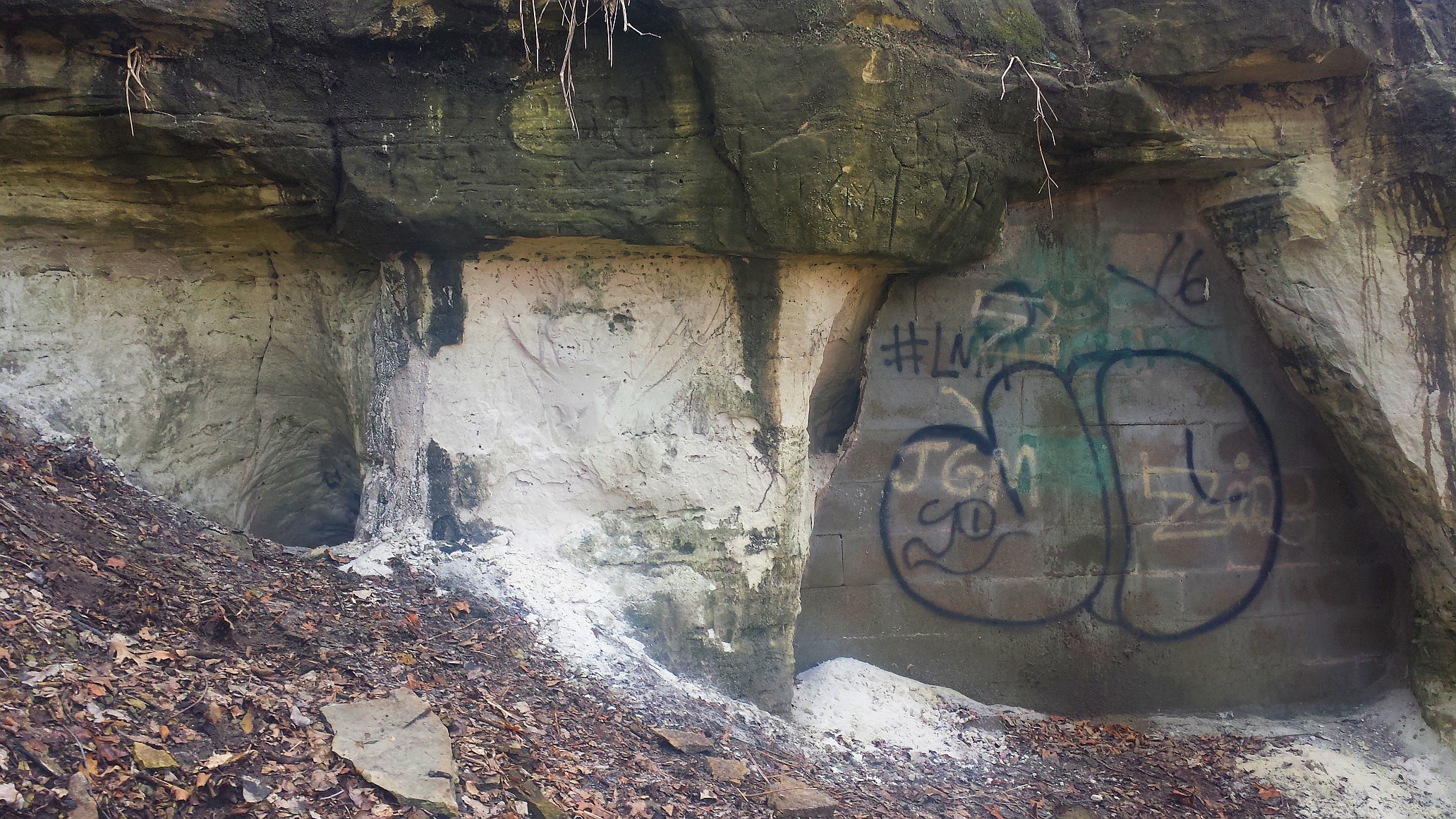 A typical Saint Peter root cellar, sealed with cinder blocks to keep out homeless people and partying teenagers.
A typical Saint Peter root cellar, sealed with cinder blocks to keep out homeless people and partying teenagers.Silica Mining
The purity of the quartz in the Saint Peter has made it a desirable commodity for many industrial applications.
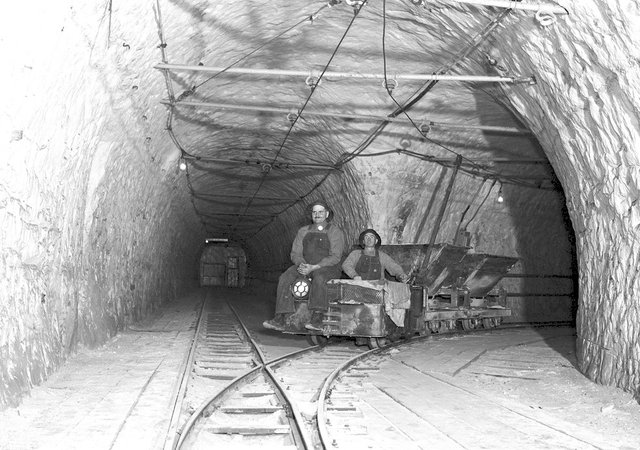 Source | Workers in the silica mines beneath the Ford Motor Company Assembly Plant removing sand along an electric rail line.
Source | Workers in the silica mines beneath the Ford Motor Company Assembly Plant removing sand along an electric rail line.Glass Manufacturing
The Ford Motor Company operated an automobile assembly plant in Saint Paul for almost 100 years. The glass used in vehicles they produced was created from local silica excavated from miles of tunnels in the nearby sandstone. Though the plant has now been demolished and the area rezoned, the longevity of this plant is likely due to the unique geographic and geologic location.Brick Making
 The entrance to Echo Cave, a former silica mine operated by the Twin Cities Brick Co. Echo Cave is gated today and serves as a bat hibernarium.
The entrance to Echo Cave, a former silica mine operated by the Twin Cities Brick Co. Echo Cave is gated today and serves as a bat hibernarium.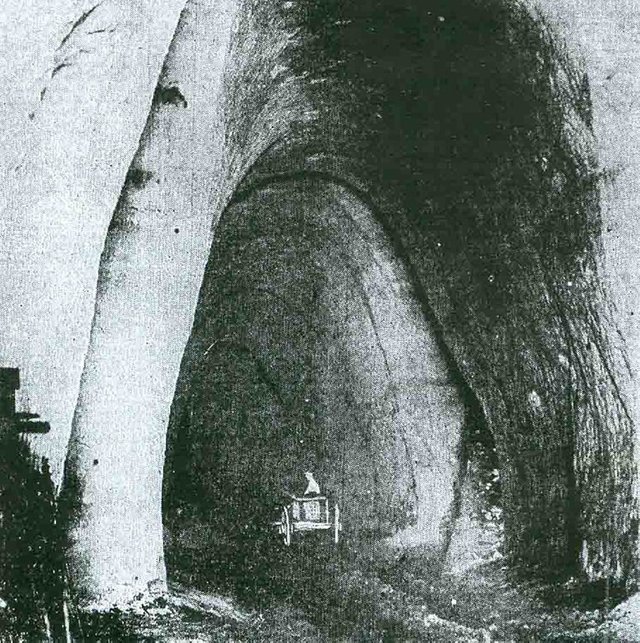 Source | A view from 1923 of one of the enormous mushroom growing caves being tended.
Source | A view from 1923 of one of the enormous mushroom growing caves being tended.Mushroom Cultivation
The cool, dark, and damp environment of the tunnels left behind from silica mining operations proved to be a prime habitat for cultivating mushrooms. A stretch of river in the south side of Saint Paul was once known as Mushroom Valley. Here, mushrooms were cultivated in horse manure on the ground (later in more sterile trays) for nearly a century. The last remaining mushroom growers were forcibly evicted from the caves about 30 years ago, but some wooden trays are alleged to remain as a tribute, slowly rotting away in the dark, forgotten space.Cheese Ripening
 Source | University of Minnesota researchers examining Roquefort-style cheese as it cave ripens.
Source | University of Minnesota researchers examining Roquefort-style cheese as it cave ripens.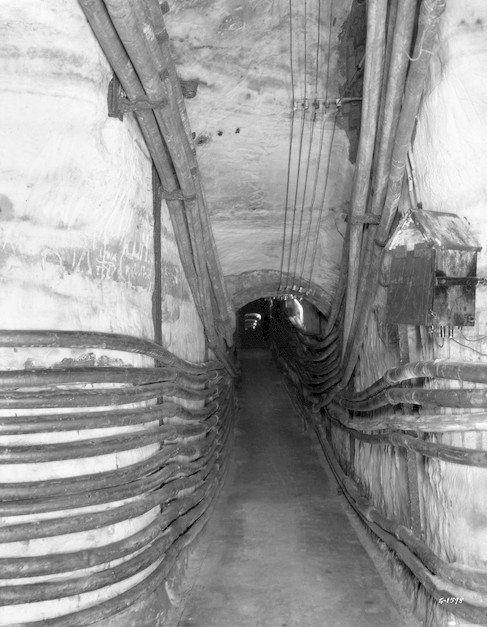 Source | Tri-State Telephone Company tunnel under St. Paul - a good example of the typical utility tunnel.
Source | Tri-State Telephone Company tunnel under St. Paul - a good example of the typical utility tunnel.Utility Tunnels
City designers and engineers quickly realized another convenient use for the Saint Peter sandstone. The ease of excavation made it possible for a complex labyrinth of utility tunnels to be excavated beneath the city of Saint Paul. The thickness of the sandstone has allowed a literal maze of tunnels to be constructed by different companies. Hundreds of miles of storm and sanitary sewers have been etched out, often by using a pressurized water spray to blast the sandrock away. Other tunnels carrying electricity, gas, water, telephone, ethernet, and pressurized steam route beneath downtown city streets in a dizzying array.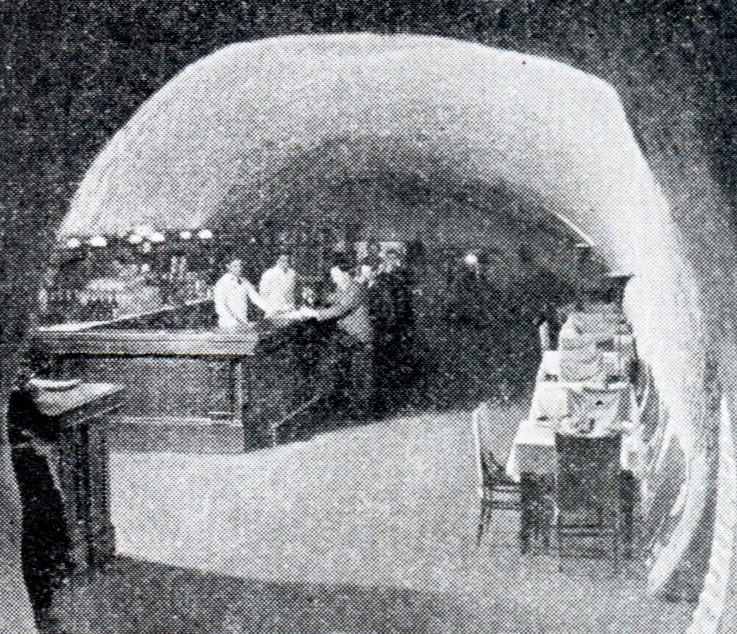 Source | From a Modern Mechanix article in 1934, Mystic Caverns night club in St. Paul was a unique venue in a Saint Peter cave.
Source | From a Modern Mechanix article in 1934, Mystic Caverns night club in St. Paul was a unique venue in a Saint Peter cave.Entertainment
In the early 20th century a couple of the sandstone caves near Mushroom Valley took on a new role - that of an underground bar. The Wabasha Street Caves, formerly the Castle Royal night club, is still in operation today as a privately-owned commercial cave venue. Another club known as Mystic Caverns operated briefly in the 1930s. It featured live music, a hall of mirrors, live entertainment, a unique bar and dining area, and a comfortable temperature year-round.Shelter
During World War II and the Cold War of the 1950s and 1960s, the caves were evaluated for their suitability as a shelter for bombing attacks and nuclear fallout. In the 1967 Fallout Shelter Location manual for St. Paul, five caves are listed as 'active shelters' stocked and ready for use. The caves are no longer suitable for this purpose.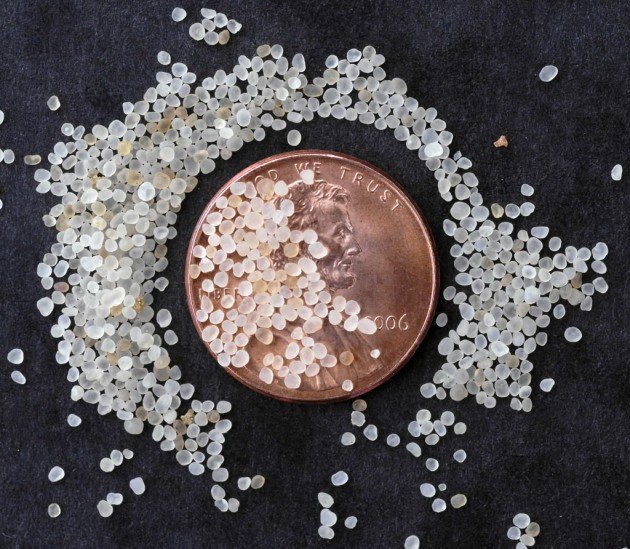 Source | Sieved Ottawa Sand (Saint Peter Sandstone) is the fracking sand of choice.
Source | Sieved Ottawa Sand (Saint Peter Sandstone) is the fracking sand of choice.Fracking
Due to their fine size and extreme roundness, sands from the Saint Peter are often implemented in the petroleum extraction technique known as hydro-fracking, or simply fracking. The controversial practice involves injecting a pressurized proprietary fluid containing dispersants into target rock units in order to create new fractures and release additional petroleum. Saint Peter sands are included with the fluid to help brace open these fractures and prevent them from resealing.Exploration
Though trespassing in them is technically illegal, the vacant caves and tunnels in the sandstone of the Twin Cities remain an alluring space for exploration. The vast networks of passages and immense vaulted ceilings entice the imagination and beckon all with the faintest interest in adventure.
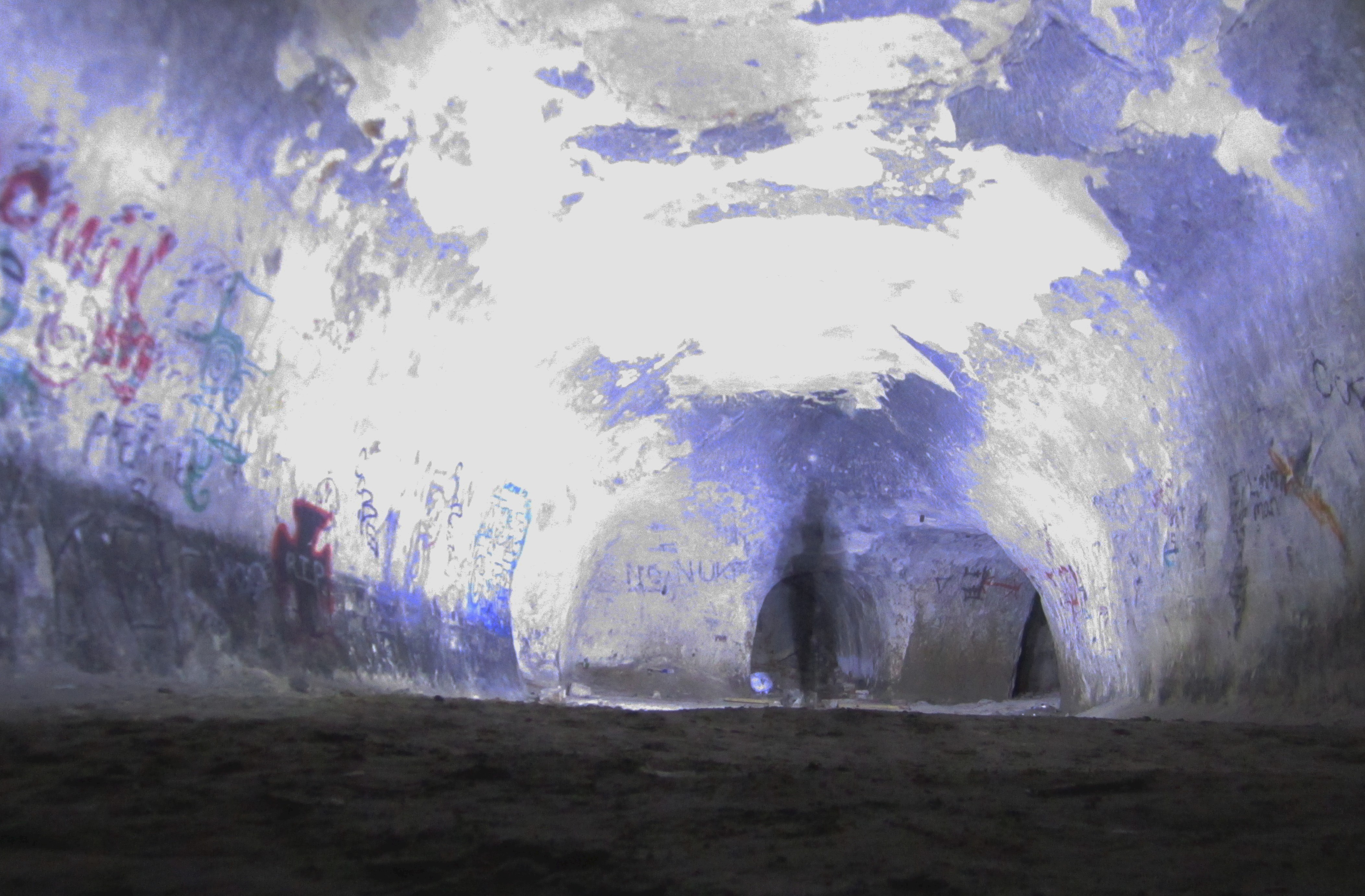 Lights and paint adorn the walls as a Wolfcat hunts for echoes of the past.
Lights and paint adorn the walls as a Wolfcat hunts for echoes of the past.Tragically, people have died in the caves over the years, and this has increased their stigma. Ironically, many of the measures that the City of St. Paul has taken to block access to these caves have merely made them more dangerous. Several of the caves are filled with rubble and flammable debris from demolished structures, while others have had all of their vents and openings sealed with concrete and rebar. 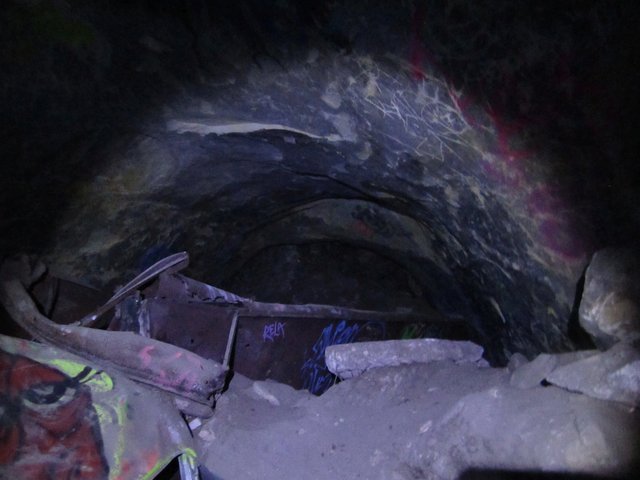 A 30-foot high cave passage almost completely filled with concrete, dirt, metal, and other debris.
A 30-foot high cave passage almost completely filled with concrete, dirt, metal, and other debris.
In a matter of weeks, explorers are able to dig new openings through the soft sandstone and regain access. However, because of sealing efforts, the natural air flow in the cave is significantly reduced. Couple this with the instinctual tendency of people to start fires for warmth or out of boredom and you have a recipe for disaster. Anyone who chooses to explore underground locations and abandoned structures should use great care and caution. Make contact with the local urban exploration groups for tips and advice on how to safely enjoy these extraordinary spaces and appreciate the Saintliest of All Sands...
External resources:
~Geologic and hydrologic aspects of tunneling in the Twin Cities area, Minnesota, United States Geological Survey (1979)
~Brick, Greg A. Subterranean Twin Cities. Minneapolis: University of Minnesota Press, 2009.
~Thiel, George A. "Sedimentary and petrographic analysis of the St. Peter sandstone." Geological Society of America Bulletin 46.4 (1935): 559-614.
~Many of the provided archive photos are from the Minnesota Historical Society
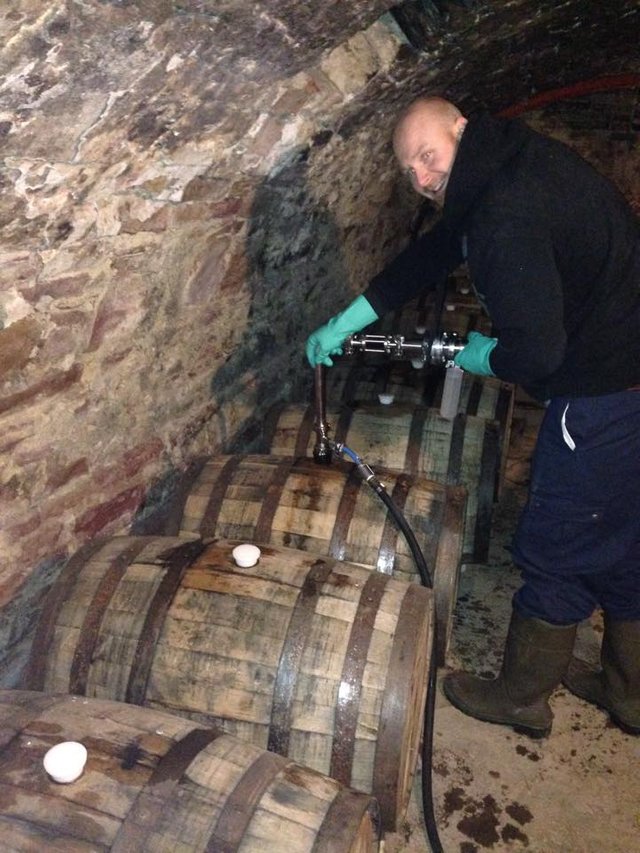

You know, I didn't think I would enjoy a post about sandstone. I opened this up and said ... well I'm never gonna finish this one. And here I am at the bottom, after caves, automaking, beer brewing and a variety of other interesting things that have happened with this Saint Peter sandstone.
Excellent post yet again @gra. I honestly don't know how you hit things out of the park every single time, but you sure as hell do. IMO you are one of the very best writers on steemit.
Wow, this comment made my day! Thank you for the praise and encouragement! I am honored to hear this from someone who has curated so much quality content.
It would be hard to write a long and interesting article about most rock units, but there was so much about the Saint Peter that I had to omit some good material for the sake of length.
I hope I can keep hitting them out of the park...at the very least, I have a renewed motivation to try! Thanks for recognizing and rewarding so many great authors!
It's a team effort and I am just one piece of it. The other members deserve much more credit then I do for identifying the wonderful posts that we try our best to give a little bit more spot light to. I am honored to be a part of the project and to serve this great and growing community of content creators (like you).
Without question, SteemSTEM is the primary reason that I haven't given up on Steemit. Your curators do an incredible job of filtering through a massive amount of content and highlighting the best. I encourage more people to sign up for the SteemSTEM voting trail!
That's very kind of you to say @gra. The team works exceptionally hard and is only minimally rewarded for those efforts (we do what we can, but we must also consider fairness to everyone else in the community). Over time, the group will continue to grow, and with that so too will our voting trail, and capacity to help more content creators get rewarded.
In the long run, it is my hope that our efforts will lead to a big enough stake (steem power) being held by the content creators of today, such that future content can be curated directly by the community itself. IE People will be able to get content trending all on their own, and that content can be supported.
We have some additional plans for implementation of an SMT relating to the steemSTEM project, which should hopefully allow us to further facilitate the generation of a community which can support itself with regards to STEM content. Where excellent content creators will have the SMT stake, to effectively distribute that new token to other high quality STEM content creators. More on that in an upcoming SteemSTEM update post though.
It sounds like there are some exciting things coming for SteemSTEM! I look forward to hearing more about SMTs and how they will help with the redistribution of the power to content creators!!
Another solid geology post @gra. Very comprehensive and on a topic I knew nothing about beforehand. Its fascinating how many applications have been derived from the caves and mining of these pure deposits of sandstone.
Thanks for checking it out and leaving a comment! I don't think I could write this much about most rock units, but the Saint Peter is in a class of its own!
I actually grew up atop the St. Peter sandstone in Kansas! Didn't see it often, though, since it was overlayed with fossiliferous limestone and glacial deposits.
As one geology nerd to another (I'm in school for geology right now), I'd love to see more of this stuff on Steemit! I'd also love to see more of a geology community on here- there's not many of us on here.
Nice! I am glad to know that there is another geology enthusiast on here...I'll be sure to keep an eye out for your posts! Slowly we will start to grow.
Slowly but surely!
Woah...what a huge amount of information. Absolutely great post. Didn't know much about it, especially not the german "beer lagering". ;)
Indeed, there is a wealth of history and information surrounding the Saint Peter and cave lagering...I might have to go more in depth with a future post. Thanks for your support!
Your post is great! The way you package your write up is wholesum. The pictures are
maverlous and astonishing, especially the golden sand on top of the coin' its wonderful.
I appreciate the support! I cannot take credit for the coin picture, but thank you!
One of the longest and informative post that I have seen here. Great Job !!
Thanks!
Very nice post, hey check this one out :D
@originalworks
The @OriginalWorks bot has determined this post by @gra to be original material and upvoted(1.5%) it!
To call @OriginalWorks, simply reply to any post with @originalworks or !originalworks in your message!
This post has received a 0.45 % upvote from @drotto thanks to: @sci-guy.